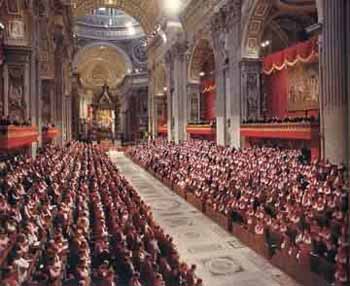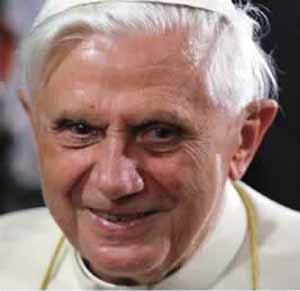 |
Consequences of Vatican II
Changing the Mentality of Catholics
Lyle J. Arnold, Jr.
At the heart of Vatican II's victory of instilling Progressivism into mainstream Catholicism was its strategy of ambiguity. This was demonstrated by A.S. Guimarães in his 11-volume collection on the Council. The title of the first volume is In the Murky Waters of Vatican II (MW). (1) Marian T. Horvat, Ph.D., wrote the Forward to this book and made a poignant statement. She said:
"The polemics over the letter and spirit of Vatican Council II has been at the center of Church life over the last three decades, and raises great passion on all sides of the religious/ideological spectrum. It takes great care, as well as rare courage, to stand up and speak frankly about what the Council mentors intended when hitherto there have been veiled allusions or undocumented accusations" (MW, p. XV).

A simultaneously pastoral and dogmatic Council |
What was it then that "the Council mentors intended"? In his opening speech of October 11, 1962, Pope John XXIII stated, "The punctum saliens [salient point] of this Council is not ... discussing one or the other article of the fundamental doctrine of the Church. ...There would be no need of a Council for that” (MW, p. 137)."'
These words set off a great schizophrenia in the Church that has haunted the Bride of Christ for half a century. Was the Council pastoral or doctrinal? One fact alone proves that at least in one sense it will "pass into history as the a-pastoral council," that is, its silence about Communism. (2)
Leaving aside this aspect, however, and addressing the Council as a whole, Guimaraes rightly defines it as “simultaneously dogmatic and pastoral.” (MW, p. 132). To achieve this, the Council’s mentors purposely employed the stratagem of ambiguity to be used as a weapon of diabolical duplicity. If the conservative Fathers complained about the abuse of doctrines, the mentors would take refuge by saying it was only pastoral. But after the Council ended, the mentors would then claim a given point was doctrinal (MW, pp. 148-180).
This, then, is "what the Council mentors intended," a double strategy that has worked to crush the conservative wing in the Church.
The aim of the Council
Pari passu, an analogous question arises: What was the general aim of the Council Fathers?
When someone is caught in the act of committing a crime, he has been caught in flagrante delicto, or, as we usually say, he was caught "red handed," with his hand still tinted with blood. A recent comment from Pope Benedict about "the aim of the Second Vatican Council's reform" places him in this position. His comment is in fact a confession. Although we in the Counter-Revolution have known for many years what "the aim of the Second Vatican Council's reform" was, I can't think of when any of the Conciliar – or post-Conciliar – Popes made this admission with such singular succinctness. Pope Ratzinger said:
The aim of Vatican II "was not principally that of changing rites and texts, but of renewing mentalities and placing the celebration of the paschal mystery of Christ at the center of Christian life and pastoral activity."

The aim of the Council is to renew mentalities... |
I will not analyze here his words about "placing the celebration of the paschal mystery…" What constitutes this “paschal mystery” is not so clear. These words come from the same old progressivist boilerplate that the Church's screeds have been churning out since Vatican II. But the first part of the phrase is nuclear. It is a confession that the Council's aim was that of “renewing mentalities.” Why was the "mentality" of the Church in need of renewal?
To renew is to "replace what is old, worn out, exhausted." Obviously the Council's aim was to "replace" the way Catholics think with a mentality that adheres to a different and antithetical doctrine. When Pope John XXIII opened the Council in 1962 the Catholic Church in the United States was in the midst of an unprecedented growth. Bishops were ordaining record number of priests and the convents were filled with young women who taught millions of students in the huge system of parochial and private schools. (3) That success was based on a conception of the Church as Militant, a Church that has to conquer the entire world for Christ.
Every Catholic - of whatever stripe - knows that all those gains today are up in smoke. The "smoke of Satan," one could say, paraphrasing Paul VI.
Why did that mentality need renewal? If the pre-conciliar mentality was producing good and healthy fruits, it does not take much probing to realize that the enemies of the Faith sought to destroy that mentality, that way of thinking. Ratzinger's admission that the true target of the Council was to change the "mentalities" of Catholics is revealing.
The mentalities of Catholics had to be destroyed and "renewed" with a new thinking and doctrine, which we call Progressivism.
A recent example
An example of this stratagem of ambiguity and another proof of the aim to change thinking and doctrine is found in a recent statement of Benedict on evolution at the Easter Vigil Papal Mass. In his talk he stressed that evolution is not a random thing, but part of God's design.

Above, the Genesis; now it is denied
St. Mark's Cathedral, Venice |
The same news report that transcribed the Pope’s talk stated, "The Vatican warns against creationism, or the overly literal interpretation of the Biblical account of creation." (4) That is to say, we are warned by the highest office in the world not to take seriously the book of Genesis, which includes the Creation of the world and of Adam.
This “new mentality” opposes the thinking of Pope St. Pius X, who warned us against the designs of Modernism regarding evolution: "To the laws of evolution everything is subject under penalty of death - dogma, Church worship, the Books we revere as sacred, even faith itself." (5)
Behold why mentalities had to be renewed: To accept evolution. To reject the book of Genesis as being authored by the Holy Ghost. In short, to bow to the lies of Progressivism, which repeats and amplifies the errors of Modernism.
Let us continue to resist this “renewal” of mentalities, and ask Our Lady to help us retain the Catholic mentality the Church has had for 2,000 years and to fight this loathsome plague called Progressivism with all our strength.
1. First published in 1997 by MAETA, In the Murky Waters of Vatican II is now in its third English edition. There is also a Spanish edition published in Chile available from TIA.
2. Plinio Corrêa de Oliveira, Revolution and Counter-Revolution, New Rochelle, NY: The Foundation for a Christian Civilization, 1980, p.149.
3. Kenneth Jones, Index of Leading Catholic Indicators: The Church Since Vatican II, on www.catholicindicators.com.
4. "Pope extols the divinity of man," Contra Costa Times, April 24, 2011, AA3
5. Pascendi Dominici Gregis, 1907, n. 26, "The evolution of doctrine."

Posted May 25, 2011

Related Topics of Interest
 Deliberate Contradictions in Vatican II Deliberate Contradictions in Vatican II
 Deadly Ambiguity Deadly Ambiguity
 Is the Council
Under Suspicion of Heresy? Is the Council
Under Suspicion of Heresy?
 The Engine and Strategies of Destruction The Engine and Strategies of Destruction
 The Insidious Tactics of Change The Insidious Tactics of Change

Related Works of Interest
|
|
Vatican II | Hot Topics | Home | Books | CDs | Search | Contact Us | Donate

© 2002-
Tradition in Action, Inc. All Rights Reserved
|
 |
|